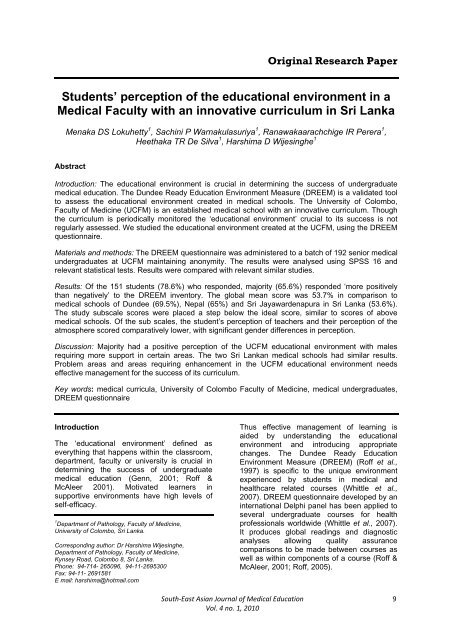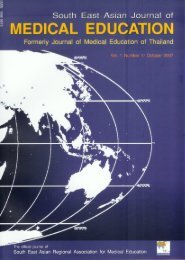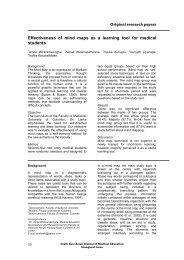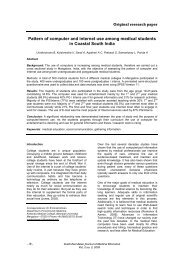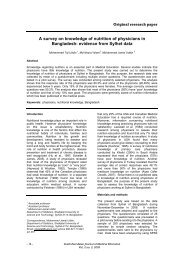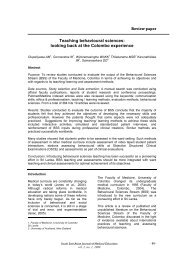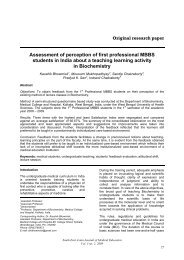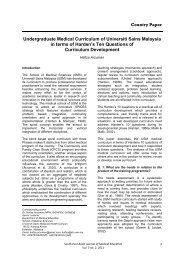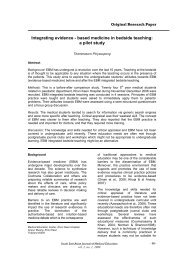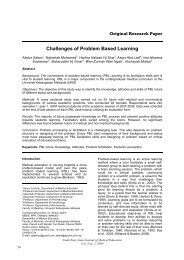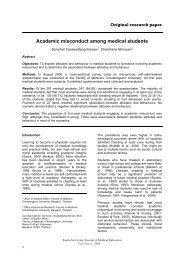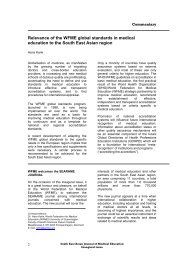Students' perception of the educational environment in a Medical ...
Students' perception of the educational environment in a Medical ...
Students' perception of the educational environment in a Medical ...
You also want an ePaper? Increase the reach of your titles
YUMPU automatically turns print PDFs into web optimized ePapers that Google loves.
Orig<strong>in</strong>al Research Paper<br />
Students’ <strong>perception</strong> <strong>of</strong> <strong>the</strong> <strong>educational</strong> <strong>environment</strong> <strong>in</strong> a<br />
<strong>Medical</strong> Faculty with an <strong>in</strong>novative curriculum <strong>in</strong> Sri Lanka<br />
Menaka DS Lokuhetty 1 , Sach<strong>in</strong>i P Warnakulasuriya 1 , Ranawakaarachchige IR Perera 1 ,<br />
Heethaka TR De Silva 1 , Harshima D Wijes<strong>in</strong>ghe 1<br />
Abstract<br />
Introduction: The <strong>educational</strong> <strong>environment</strong> is crucial <strong>in</strong> determ<strong>in</strong><strong>in</strong>g <strong>the</strong> success <strong>of</strong> undergraduate<br />
medical education. The Dundee Ready Education Environment Measure (DREEM) is a validated tool<br />
to assess <strong>the</strong> <strong>educational</strong> <strong>environment</strong> created <strong>in</strong> medical schools. The University <strong>of</strong> Colombo,<br />
Faculty <strong>of</strong> Medic<strong>in</strong>e (UCFM) is an established medical school with an <strong>in</strong>novative curriculum. Though<br />
<strong>the</strong> curriculum is periodically monitored <strong>the</strong> ‘<strong>educational</strong> <strong>environment</strong>’ crucial to its success is not<br />
regularly assessed. We studied <strong>the</strong> <strong>educational</strong> <strong>environment</strong> created at <strong>the</strong> UCFM, us<strong>in</strong>g <strong>the</strong> DREEM<br />
questionnaire.<br />
Materials and methods: The DREEM questionnaire was adm<strong>in</strong>istered to a batch <strong>of</strong> 192 senior medical<br />
undergraduates at UCFM ma<strong>in</strong>ta<strong>in</strong><strong>in</strong>g anonymity. The results were analysed us<strong>in</strong>g SPSS 16 and<br />
relevant statistical tests. Results were compared with relevant similar studies.<br />
Results: Of <strong>the</strong> 151 students (78.6%) who responded, majority (65.6%) responded ‘more positively<br />
than negatively’ to <strong>the</strong> DREEM <strong>in</strong>ventory. The global mean score was 53.7% <strong>in</strong> comparison to<br />
medical schools <strong>of</strong> Dundee (69.5%), Nepal (65%) and Sri Jayawardenapura <strong>in</strong> Sri Lanka (53.6%).<br />
The study subscale scores were placed a step below <strong>the</strong> ideal score, similar to scores <strong>of</strong> above<br />
medical schools. Of <strong>the</strong> sub scales, <strong>the</strong> student’s <strong>perception</strong> <strong>of</strong> teachers and <strong>the</strong>ir <strong>perception</strong> <strong>of</strong> <strong>the</strong><br />
atmosphere scored comparatively lower, with significant gender differences <strong>in</strong> <strong>perception</strong>.<br />
Discussion: Majority had a positive <strong>perception</strong> <strong>of</strong> <strong>the</strong> UCFM <strong>educational</strong> <strong>environment</strong> with males<br />
requir<strong>in</strong>g more support <strong>in</strong> certa<strong>in</strong> areas. The two Sri Lankan medical schools had similar results.<br />
Problem areas and areas requir<strong>in</strong>g enhancement <strong>in</strong> <strong>the</strong> UCFM <strong>educational</strong> <strong>environment</strong> needs<br />
effective management for <strong>the</strong> success <strong>of</strong> its curriculum.<br />
Key words: medical curricula, University <strong>of</strong> Colombo Faculty <strong>of</strong> Medic<strong>in</strong>e, medical undergraduates,<br />
DREEM questionnaire<br />
Introduction<br />
The ‘<strong>educational</strong> <strong>environment</strong>’ def<strong>in</strong>ed as<br />
everyth<strong>in</strong>g that happens with<strong>in</strong> <strong>the</strong> classroom,<br />
department, faculty or university is crucial <strong>in</strong><br />
determ<strong>in</strong><strong>in</strong>g <strong>the</strong> success <strong>of</strong> undergraduate<br />
medical education (Genn, 2001; R<strong>of</strong>f &<br />
McAleer 2001). Motivated learners <strong>in</strong><br />
supportive <strong>environment</strong>s have high levels <strong>of</strong><br />
self-efficacy.<br />
1<br />
Department <strong>of</strong> Pathology, Faculty <strong>of</strong> Medic<strong>in</strong>e,<br />
University <strong>of</strong> Colombo, Sri Lanka.<br />
Correspond<strong>in</strong>g author: Dr Harshima Wijes<strong>in</strong>ghe,<br />
Department <strong>of</strong> Pathology, Faculty <strong>of</strong> Medic<strong>in</strong>e,<br />
Kynsey Road, Colombo 8, Sri Lanka.<br />
Phone: 94-714- 265096, 94-11-2695300<br />
Fax: 94-11- 2691581<br />
E mail: harshima@hotmail.com<br />
Thus effective management <strong>of</strong> learn<strong>in</strong>g is<br />
aided by understand<strong>in</strong>g <strong>the</strong> <strong>educational</strong><br />
<strong>environment</strong> and <strong>in</strong>troduc<strong>in</strong>g appropriate<br />
changes. The Dundee Ready Education<br />
Environment Measure (DREEM) (R<strong>of</strong>f et al.,<br />
1997) is specific to <strong>the</strong> unique <strong>environment</strong><br />
experienced by students <strong>in</strong> medical and<br />
healthcare related courses (Whittle et al.,<br />
2007). DREEM questionnaire developed by an<br />
<strong>in</strong>ternational Delphi panel has been applied to<br />
several undergraduate courses for health<br />
pr<strong>of</strong>essionals worldwide (Whittle et al., 2007).<br />
It produces global read<strong>in</strong>gs and diagnostic<br />
analyses allow<strong>in</strong>g quality assurance<br />
comparisons to be made between courses as<br />
well as with<strong>in</strong> components <strong>of</strong> a course (R<strong>of</strong>f &<br />
McAleer, 2001; R<strong>of</strong>f, 2005).<br />
South‐East Asian Journal <strong>of</strong> <strong>Medical</strong> Education 9<br />
Vol. 4 no. 1, 2010
The Faculty <strong>of</strong> Medic<strong>in</strong>e <strong>of</strong> <strong>the</strong> University <strong>of</strong><br />
Colombo (UCFM) is an established medical<br />
school with a history <strong>of</strong> 140 years. Its<br />
traditional discipl<strong>in</strong>e based curriculum was<br />
replaced by an <strong>in</strong>novative, <strong>in</strong>tegrated<br />
curriculum <strong>in</strong> 1995. The current curriculum<br />
<strong>in</strong>cludes five streams compris<strong>in</strong>g Introductory<br />
Basic Sciences, Applied Sciences, Behavioral<br />
Sciences, Cl<strong>in</strong>ical Sciences and Community<br />
Streams with vary<strong>in</strong>g emphasis at different<br />
stages <strong>of</strong> <strong>the</strong> curriculum. The curriculum and<br />
its delivery are periodically monitored,<br />
however <strong>the</strong> ‘<strong>educational</strong> <strong>environment</strong>’ crucial<br />
to <strong>the</strong> success <strong>of</strong> undergraduate medical<br />
education is not regularly assessed. Thus we<br />
aimed to assess <strong>the</strong> students’ <strong>perception</strong> <strong>of</strong><br />
<strong>the</strong> <strong>educational</strong> <strong>environment</strong> at <strong>the</strong> UCFM<br />
us<strong>in</strong>g <strong>the</strong> DREEM questionnaire and to<br />
compare results with relevant similar studies.<br />
Methods<br />
All students (n=192) <strong>in</strong> a batch <strong>of</strong> senior<br />
UCFM medical undergraduates adequately<br />
exposed to <strong>the</strong> five curricular streams and to<br />
different modalities <strong>of</strong> teach<strong>in</strong>g and learn<strong>in</strong>g<br />
comprised <strong>the</strong> study population. The gender<br />
distribution <strong>of</strong> <strong>the</strong> population was almost<br />
equal.<br />
Ethical clearance was obta<strong>in</strong>ed from <strong>the</strong><br />
UCFM ethics committee. After expla<strong>in</strong><strong>in</strong>g <strong>the</strong><br />
study and <strong>the</strong> DREEM questionnaire and<br />
obta<strong>in</strong><strong>in</strong>g <strong>the</strong>ir consent, it was adm<strong>in</strong>istered to<br />
<strong>the</strong> study population on 25.01.2008.<br />
Anonymity was ma<strong>in</strong>ta<strong>in</strong>ed.<br />
SPSS 16, Mann Whitney's U test and chi<br />
square tests were used to analyze data based<br />
on DREEM guidel<strong>in</strong>es. DREEM consists <strong>of</strong> 50<br />
items relevant to <strong>the</strong> <strong>educational</strong> climate. Each<br />
positive statement scores 0-4 on a 5-po<strong>in</strong>t<br />
scale and <strong>the</strong> negative statements score <strong>in</strong><br />
reverse. Items with a mean score <strong>of</strong> 3 and<br />
above are considered positive and items with<br />
a mean score <strong>of</strong> 2 and below are considered<br />
as problem areas and were identified <strong>in</strong> <strong>the</strong><br />
study population. Items with a mean score<br />
between 2 and 3 are considered as aspects <strong>of</strong><br />
<strong>the</strong> <strong>educational</strong> <strong>environment</strong> that require<br />
enhancement. DREEM has five subscales and<br />
a maximum total score <strong>of</strong> 200, <strong>in</strong>dicat<strong>in</strong>g an<br />
ideal <strong>educational</strong> <strong>environment</strong>. The subscales<br />
comprise: 1.Students’ <strong>perception</strong> <strong>of</strong> learn<strong>in</strong>g<br />
(SPL), 2.Students’ <strong>perception</strong> <strong>of</strong> teachers<br />
(SPT), 3.Students’ academic self-<strong>perception</strong><br />
(SAS), 4.Students’ <strong>perception</strong> <strong>of</strong> atmosphere<br />
(SPA), and 5.Students’ social self-<strong>perception</strong><br />
(SSS). The scores for each subscale were<br />
<strong>in</strong>terpreted on a four-tiered scale, <strong>the</strong> top tier<br />
represent<strong>in</strong>g <strong>the</strong> highest score <strong>in</strong>dicat<strong>in</strong>g an<br />
ideal situation. The bottom tier represents <strong>the</strong><br />
lowest score and a less ideal situation (R<strong>of</strong>f et<br />
al., 1997).<br />
The results were compared with DREEM<br />
studies from South Asia at BP Koirala Institute<br />
<strong>of</strong> Health Sciences <strong>in</strong> Dharan Nepal (BPKI<br />
HSN) (R<strong>of</strong>f et al., 2001), <strong>the</strong> prelim<strong>in</strong>ary<br />
DREEM study sett<strong>in</strong>g at University <strong>of</strong> Dundee,<br />
UK (DU) (Al-Hazimi et al., 2004) and <strong>the</strong> s<strong>in</strong>gle<br />
documented study from Sri Lanka, from<br />
Faculty <strong>of</strong> <strong>Medical</strong> Sciences, University <strong>of</strong> Sri<br />
Jayawardenapura (Jiffry et al., 2005).<br />
Results<br />
There were 151 respondents (78.6%) to <strong>the</strong><br />
DREEM questionnaire with females<br />
account<strong>in</strong>g for 64.24% (n=97). Majority<br />
(65.6%) responded ‘more positively than<br />
negatively’ to DREEM at UCFM. ‘A more<br />
positive <strong>perception</strong>’ was observed among<br />
68.2% for students’ <strong>perception</strong>s <strong>of</strong> learn<strong>in</strong>g<br />
(SPL, sample mean score 26.8). Fur<strong>the</strong>rmore,<br />
55% perceived that teachers are ‘mov<strong>in</strong>g <strong>in</strong><br />
<strong>the</strong> right direction’ for students’ <strong>perception</strong> <strong>of</strong><br />
teachers (SPT, sample mean score 22.7). The<br />
majority (69.5%) also had an academic self<br />
<strong>perception</strong> that was ‘more on <strong>the</strong> positive side’<br />
(SAS, sample mean score 18.2). Faculty<br />
atmosphere was perceived as ‘a more positive<br />
atmosphere’ (SPA, sample mean score 24.7)<br />
by 50.3% while 46.4% thought that <strong>the</strong>re are<br />
issues that need chang<strong>in</strong>g. More than half<br />
(52.3%) thought that <strong>the</strong> society <strong>the</strong>y live <strong>in</strong> is<br />
‘not too bad’ (SSS, sample mean score 14.8)<br />
while 42.4% believed <strong>the</strong>ir society is ‘not a<br />
nice place to be’. The five subscales scores<br />
were a step below <strong>the</strong> ideal on <strong>the</strong> four tiered<br />
scale. Students’ <strong>perception</strong> <strong>of</strong> teachers and<br />
students’ <strong>perception</strong> <strong>of</strong> atmosphere obta<strong>in</strong>ed<br />
<strong>the</strong> lowest mean scores among <strong>the</strong> subscales.<br />
(Table 1).<br />
A gender based significant difference was<br />
observed with regard to teach<strong>in</strong>g be<strong>in</strong>g<br />
sufficiently concerned to develop competence<br />
(p
Table 1: Scores obta<strong>in</strong>ed for subscales by <strong>the</strong> study population<br />
DREEM and its<br />
subscales<br />
Maximum<br />
Score<br />
Sample Mean<br />
Score<br />
(S.D.)<br />
All items 200 107.43<br />
Students’<br />
<strong>perception</strong>s <strong>of</strong><br />
learn<strong>in</strong>g<br />
(16.27)<br />
48 26.87<br />
(5.16)<br />
Categorization <strong>of</strong> Subscales (%)<br />
Very poor 0.70<br />
Plenty <strong>of</strong> problems 33.10<br />
More positive than negative 65.60<br />
Excellent 0.70<br />
Very poor 0.70<br />
Teach<strong>in</strong>g is viewed negatively 29.80<br />
A more positive <strong>perception</strong> 68.20<br />
Teach<strong>in</strong>g highly thought <strong>of</strong> 1.30<br />
Students’<br />
<strong>perception</strong>s <strong>of</strong><br />
teachers<br />
44 22.74<br />
(3.96)<br />
Abysmal 0.70<br />
In need <strong>of</strong> some retra<strong>in</strong><strong>in</strong>g 44.30<br />
Mov<strong>in</strong>g <strong>in</strong> <strong>the</strong> right direction 55.00<br />
Model teachers 0.00<br />
Feel<strong>in</strong>gs <strong>of</strong> total failure 2.00<br />
Students’<br />
academic self<strong>perception</strong><br />
Students’<br />
<strong>perception</strong>s <strong>of</strong><br />
atmosphere<br />
Students’ social<br />
self-<strong>perception</strong><br />
32 18.22<br />
(3.52)<br />
48 24.72<br />
(5.42)<br />
28 14.87<br />
(3.78)<br />
Many negative aspects 26.50<br />
Feel<strong>in</strong>g more on <strong>the</strong> positive<br />
side<br />
69.50<br />
Confident 2.00<br />
A terrible <strong>environment</strong> 2.60<br />
There are many issues which<br />
need chang<strong>in</strong>g<br />
DREEM = Dundee Ready Education Environment Measure, S.D. = Standard deviation<br />
46.40<br />
A more positive atmosphere 50.30<br />
A good feel<strong>in</strong>g overall 0.70<br />
Miserable 3.30<br />
Not a nice place 42.40<br />
Not too bad 52.30<br />
Very good socially 2.00<br />
The difference was significant among <strong>the</strong> two<br />
genders for <strong>the</strong> questions ‘<strong>the</strong>re are<br />
opportunities for me to develop <strong>in</strong>terpersonal<br />
skills’ (p
and less authoritarian and perceived <strong>the</strong>se as<br />
problem areas. Not be<strong>in</strong>g able to memorize all<br />
<strong>the</strong>y need was a problem for <strong>the</strong> study<br />
population <strong>in</strong> <strong>the</strong> students’ academic self<br />
<strong>perception</strong> subscale. O<strong>the</strong>r areas <strong>in</strong> <strong>the</strong><br />
subscale were perceived as areas requir<strong>in</strong>g<br />
enhancement. Several problem areas were<br />
identified <strong>in</strong> <strong>the</strong> subscale students’ <strong>perception</strong><br />
<strong>of</strong> atmosphere <strong>in</strong>dicat<strong>in</strong>g an atmosphere that<br />
is less motivational and stressful. In <strong>the</strong><br />
students’ social self <strong>perception</strong> subscale, <strong>the</strong><br />
study group agreed <strong>the</strong>y had problems with<br />
<strong>the</strong> support systems available for those who<br />
get stressed.<br />
Table 2: Item gender scores, p values <strong>of</strong> item gender scores and item mean scores obta<strong>in</strong>ed <strong>in</strong> <strong>the</strong><br />
UCFM study population.<br />
Statement M F p value<br />
(M/F)<br />
UCFM<br />
(M+F)<br />
Students’ <strong>perception</strong> <strong>of</strong> learn<strong>in</strong>g:<br />
1. I am encouraged to participate <strong>in</strong> class 2.70 2.51 >0.05 2.58*<br />
7. The teach<strong>in</strong>g is <strong>of</strong>ten stimulat<strong>in</strong>g 2.00 2.14 >0.05 2.09*<br />
13.The teach<strong>in</strong>g is student-centered 2.31 2.67 >0.05 2.54*<br />
16.The teach<strong>in</strong>g is sufficiently concerned to develop my competence 1.98 2.34 0.05 2.42*<br />
22.The teach<strong>in</strong>g is sufficiently concerned to develop my confidence 2.00 2.01 >0.05 2.21*<br />
24.The teach<strong>in</strong>g time is put to good use 2.20 2.39 >0.05 2.32*<br />
25.The teach<strong>in</strong>g over- emphasized factual learn<strong>in</strong>g 1.56 1.74 >0.05 1.68˜<br />
38. I am clear about <strong>the</strong> learn<strong>in</strong>g objectives <strong>of</strong> <strong>the</strong> course 2.17 2.34 >0.05 2.28*<br />
44.The teach<strong>in</strong>g encourages me to be an active learner 2.11 2.20 >0.05 2.17*<br />
47.Long term learn<strong>in</strong>g is emphasized over <strong>the</strong> short term 2.46 2.52 >0.05 2.50*<br />
48.The teach<strong>in</strong>g is too teacher-centered 1.89 2.19 >0.05 2.08*<br />
Students’ <strong>perception</strong> <strong>of</strong> teachers:<br />
2. The teachers are knowledgeable 3.19 3.15 >0.05 3.17˚<br />
6. The teachers are patient with patients 2.33 2.34 >0.05 2.34*<br />
8. The teachers ridicule <strong>the</strong> students 1.50 1.57 >0.05 1.54˜<br />
9. The teachers are authoritarian 1.24 1.57 >0.05 1.45˜<br />
18.The teachers have good communication skills with patients 2.20 2.37 >0.05 2.31*<br />
29.The teachers are good at provid<strong>in</strong>g feedback to students 1.69 1.74 >0.05 1.72˜<br />
32.The teachers provide constructive criticism here 2.00 2.32 0.05 2.41*<br />
39.The teachers get angry <strong>in</strong> class 1.44 1.32 >0.05 1.36˜<br />
40.The teachers are well prepared for <strong>the</strong>ir classes 2.48 2.60 >0.05 2.56*<br />
50.The students irritate <strong>the</strong> teachers 1.52 1.76 >0.05 1.68˜<br />
Students’ academic self <strong>perception</strong>:<br />
5. Learn<strong>in</strong>g strategies which worked for me before cont<strong>in</strong>ue to work for me<br />
now<br />
2.11 2.15 >0.05 2.14*<br />
10. I am confident about pass<strong>in</strong>g this year 2.78 2.64 >0.05 2.69*<br />
21. I feel I am be<strong>in</strong>g well prepared for my pr<strong>of</strong>ession 2.15 2.13 >0.05 2.14*<br />
26. Last year’s work has been a good preparation for this year’s work 2.04 2.19 >0.05 2.13*<br />
27. I am able to memorize all I need 1.61 1.41 >0.05 1.48˜<br />
31. I have learned a lot about empathy <strong>in</strong> my pr<strong>of</strong>ession 2.33 2.88 0.05 2.21*<br />
45. Much <strong>of</strong> what I have to learn seems relevant to a career <strong>in</strong> medic<strong>in</strong>e 2.57 2.85 >0.05 2.75*<br />
12 South‐East Asian Journal <strong>of</strong> <strong>Medical</strong> Education<br />
Vol. 4 no. 1, 2010
Statement M F p value<br />
(M/F)<br />
UCFM<br />
(M+F)<br />
Students’ <strong>perception</strong> <strong>of</strong> atmosphere:<br />
11.The atmosphere is relaxed dur<strong>in</strong>g <strong>the</strong> ward teach<strong>in</strong>g 1.57 1.53 >0.05 1.54˜<br />
12.This school is well timetabled 2.15 2.29 >0.05 2.24*<br />
17.Cheat<strong>in</strong>g is a problem <strong>in</strong> this school 2.02 1.88 >0.05 1.93˜<br />
23.The atmosphere is relaxed dur<strong>in</strong>g lectures 2.41 2.54 >0.05 2.49*<br />
30.There are opportunities for me to develop <strong>in</strong>terpersonal skills 2.54 2.56 0.05 1.69˜<br />
43.The atmosphere motivates me as a learner 1.85 1.92 >0.05 1.89˜<br />
49. I feel able to ask <strong>the</strong> questions I want 2.04 1.79 >0.05 1.88˜<br />
Students’ social self <strong>perception</strong>:<br />
3. There is a good support system for students who get stressed 1.43 1.43 >0.05 1.43˜<br />
4. I am too tired to enjoy this course 1.50 1.36 >0.05 1.41˜<br />
14. I am rarely bored on this course 1.85 1.81 >0.05 1.83˜<br />
15. I have good friends <strong>in</strong> <strong>the</strong> school 2.37 2.90
Table 3: Comparison <strong>of</strong> sample mean scores <strong>of</strong> <strong>the</strong> study population with studies from University <strong>of</strong><br />
Dundee, BP Koirala Institute <strong>of</strong> Health Sciences, Nepal and Faculty <strong>of</strong> <strong>Medical</strong> Sciences,<br />
University <strong>of</strong> Sri Jayawardenapura, Sri Lanka<br />
DREEM and its subscales<br />
UCFM<br />
Sample Mean<br />
Score<br />
(percentages)<br />
DU<br />
Sample Mean<br />
Score<br />
(percentages)<br />
BPKI HSN<br />
Sample Mean<br />
Score<br />
(percentages)<br />
FMS/USJ<br />
Sample Mean<br />
Score<br />
(percentages)<br />
All items<br />
107.4<br />
139<br />
130<br />
107.2<br />
(/200)<br />
(53.72%)<br />
(69.50%)<br />
(65.00%)<br />
(53.6%)<br />
Students’ <strong>perception</strong>s <strong>of</strong><br />
learn<strong>in</strong>g (/48)<br />
26.8<br />
(55.98%)<br />
34<br />
(70.83%)<br />
33<br />
(68.75%)<br />
25.6<br />
(53.33%)<br />
Students’ <strong>perception</strong>s <strong>of</strong><br />
teachers (/44)<br />
22.7<br />
(51.68%)<br />
29<br />
(65.91%)<br />
26<br />
(59.09%)<br />
23.3<br />
(52.96%)<br />
Students’ academic self<strong>perception</strong><br />
(/32)<br />
18.2<br />
(56.94%)<br />
23<br />
(71.88%)<br />
22<br />
(68.75%)<br />
17.5<br />
(23.44%)<br />
Students’ <strong>perception</strong>s <strong>of</strong><br />
atmosphere (/48)<br />
24.7<br />
(51.50%)<br />
35<br />
(72.92%)<br />
32<br />
(66.67%)<br />
24.9<br />
(51.87%)<br />
Students’ social self<strong>perception</strong><br />
(/28)<br />
14.8<br />
(53.11%)<br />
20<br />
(71.43%)<br />
18<br />
(64.24%)<br />
15.2<br />
(54.29%)<br />
BPKI HSN = BP Koirala Institute <strong>of</strong> Health Sciences, Nepal, DREEM = Dundee Ready Education Environment Measure<br />
DU = University <strong>of</strong> Dundee, FMS/USJ = Faculty <strong>of</strong> <strong>Medical</strong> Sciences, University <strong>of</strong> Sri Jayawardenapura<br />
UCFM = University <strong>of</strong> Colombo, Faculty <strong>of</strong> Medic<strong>in</strong>e<br />
The study scores were lower than those<br />
obta<strong>in</strong>ed at University <strong>of</strong> Dundee and BP<br />
Koirala Institute <strong>of</strong> Health Sciences <strong>in</strong> Dharan,<br />
Nepal, while be<strong>in</strong>g similar to those obta<strong>in</strong>ed at<br />
Faculty <strong>of</strong> <strong>Medical</strong> Sciences, University <strong>of</strong> Sri<br />
Jayawardenapura <strong>in</strong> Sri Lanka which utilized<br />
pooled data. The subscale scores were<br />
similarly low especially <strong>in</strong> students’ <strong>perception</strong><br />
<strong>of</strong> teachers and students’ <strong>perception</strong> <strong>of</strong><br />
atmosphere subscales <strong>in</strong> both studies from Sri<br />
Lanka (Table 3).<br />
Discussion<br />
The response rate among males for DREEM<br />
at UCFM was lower than that <strong>of</strong> <strong>the</strong> female<br />
response rate irrespective <strong>of</strong> <strong>the</strong> almost equal<br />
gender distribution <strong>of</strong> <strong>the</strong> study population.<br />
The males also scored more negatively on<br />
several aspects <strong>of</strong> <strong>the</strong> <strong>educational</strong> <strong>environment</strong><br />
than females and perceived more lonel<strong>in</strong>ess.<br />
Females scored more negatively than males<br />
only with regard to a relaxed atmosphere<br />
dur<strong>in</strong>g sem<strong>in</strong>ars/tutorials. Similarly at Melaka<br />
Manipal <strong>Medical</strong> College <strong>in</strong> India (Reem et al.,<br />
2007), <strong>the</strong> females had a more positive<br />
<strong>perception</strong> than males on many aspects,<br />
among both academic underachievers and<br />
achievers. However this gender-based<br />
difference <strong>of</strong> <strong>perception</strong> was not evident <strong>in</strong> a<br />
subsequent DREEM analysis done at <strong>the</strong><br />
same campus among first year and cl<strong>in</strong>ical<br />
phase students (Reem et al., 2008). Some <strong>of</strong><br />
<strong>the</strong> statistically significant gender differences<br />
observed at UCFM could be due to more<br />
supportive <strong>in</strong>terpersonal relationships/empa<strong>the</strong>tic<br />
behaviours among females <strong>in</strong> <strong>the</strong> study<br />
population. The study results <strong>in</strong>dicate that <strong>the</strong><br />
males require more support to develop<br />
competence, empathy, <strong>in</strong>terpersonal skills and<br />
a good social life <strong>in</strong> comparison to females<br />
among this group at <strong>the</strong> UCFM.<br />
The batch <strong>of</strong> senior medical undergraduates<br />
compris<strong>in</strong>g <strong>the</strong> study population at UCFM,<br />
perceived <strong>the</strong>ir <strong>educational</strong> <strong>environment</strong> to be<br />
more positive. The study also identifies certa<strong>in</strong><br />
problem areas as well as areas <strong>in</strong> <strong>the</strong>ir<br />
<strong>educational</strong> <strong>environment</strong> that require<br />
enhancement. It is necessary to streng<strong>the</strong>n<br />
<strong>the</strong>se identified areas especially <strong>in</strong> <strong>the</strong><br />
students’ <strong>perception</strong> <strong>of</strong> teachers and students’<br />
<strong>perception</strong> <strong>of</strong> atmosphere sub doma<strong>in</strong>s, for<br />
effective management <strong>of</strong> learn<strong>in</strong>g for <strong>the</strong><br />
success <strong>of</strong> <strong>the</strong> curriculum.<br />
14 South‐East Asian Journal <strong>of</strong> <strong>Medical</strong> Education<br />
Vol. 4 no. 1, 2010
Some <strong>of</strong> <strong>the</strong> problem areas identified <strong>in</strong> <strong>the</strong><br />
study population have also been identified as<br />
problems encountered <strong>in</strong> medical schools with<br />
traditional curricula by Al Hazimi and<br />
coauthors (2004). They documented that<br />
students <strong>in</strong> traditional medical curricula<br />
perceived teach<strong>in</strong>g as be<strong>in</strong>g too teacher<br />
centered, over emphasiz<strong>in</strong>g factual learn<strong>in</strong>g<br />
with more authoritarian teachers. It was also<br />
observed that <strong>the</strong> students <strong>in</strong> <strong>the</strong>se<br />
<strong>environment</strong>s were more likely to feel tired,<br />
less able to memorize all <strong>the</strong>y needed and<br />
were less likely to enjoy <strong>the</strong> course. However<br />
<strong>the</strong> UCFM curriculum is not considered a<br />
traditional curriculum. Thus study<strong>in</strong>g <strong>the</strong><br />
<strong>perception</strong>s <strong>of</strong> a wider group <strong>of</strong> students<br />
compris<strong>in</strong>g students <strong>in</strong> <strong>the</strong> early phase <strong>of</strong> <strong>the</strong>ir<br />
course as well those who have completed <strong>the</strong><br />
course would enable a wider <strong>perception</strong> <strong>of</strong> <strong>the</strong><br />
<strong>educational</strong> <strong>environment</strong> created at <strong>the</strong><br />
<strong>in</strong>stitution and its actual impact on <strong>the</strong><br />
curriculum.<br />
Although <strong>the</strong> overall <strong>perception</strong> <strong>of</strong> <strong>the</strong><br />
<strong>educational</strong> <strong>environment</strong> at <strong>the</strong> UCFM was<br />
more positive, <strong>the</strong> global mean score <strong>of</strong> <strong>the</strong><br />
study sample was lower than what was<br />
observed <strong>in</strong> studies from University <strong>of</strong> Dundee<br />
and BP Koirala Institute <strong>of</strong> Health Sciences <strong>in</strong><br />
Dharan Nepal and was similar to <strong>the</strong> study<br />
results from Faculty <strong>of</strong> <strong>Medical</strong> Sciences,<br />
University <strong>of</strong> Sri Jayawardenapura <strong>in</strong> Sri<br />
Lanka. The entry criterion for state universities<br />
<strong>in</strong> Sri Lanka is based on <strong>the</strong> merit score<br />
obta<strong>in</strong>ed at <strong>the</strong> highly competitive National<br />
Advanced Level Exam<strong>in</strong>ation. The students<br />
who ga<strong>in</strong> entry to study medic<strong>in</strong>e are those<br />
who achieve high merit scores at this highly<br />
competitive exam<strong>in</strong>ation. Thus it is possible<br />
that <strong>the</strong> students are already academically<br />
challenged at entry and are more prone to<br />
stress dur<strong>in</strong>g <strong>the</strong>ir undergraduate studies. This<br />
may have contributed to similar global mean<br />
scores and sub doma<strong>in</strong> scores obta<strong>in</strong>ed for<br />
DREEM from <strong>the</strong> two Sri Lankan medical<br />
schools (UCFM and FMS/USJ) and to <strong>the</strong><br />
differences observed with <strong>the</strong> regional study<br />
from BP Koirala Institute <strong>of</strong> Health Sciences <strong>in</strong><br />
Dharan, Nepal.<br />
The students’ <strong>perception</strong> <strong>of</strong> emphasized<br />
factual learn<strong>in</strong>g lead<strong>in</strong>g to memorization and<br />
stress <strong>in</strong> <strong>the</strong> medical school may also be<br />
broadly rooted <strong>in</strong> <strong>the</strong>ir acquired study habits<br />
related to over emphasized factual learn<strong>in</strong>g for<br />
<strong>the</strong> entry level exam<strong>in</strong>ation. It may be possible<br />
to overcome <strong>the</strong>se problems by redesign<strong>in</strong>g<br />
<strong>the</strong> <strong>in</strong>duction course at entry level to address<br />
<strong>the</strong>se issues.<br />
Conclusion<br />
The senior batch <strong>of</strong> medical undergraduates<br />
compris<strong>in</strong>g <strong>the</strong> study population at <strong>the</strong> UCFM,<br />
perceived <strong>the</strong>ir <strong>educational</strong> <strong>environment</strong> to be<br />
more positive. Certa<strong>in</strong> problem areas and<br />
areas that require enhancement <strong>in</strong> <strong>the</strong> UCFM<br />
<strong>educational</strong> <strong>environment</strong> were identified for<br />
effective management <strong>of</strong> learn<strong>in</strong>g especially <strong>in</strong><br />
<strong>the</strong> students’ <strong>perception</strong> <strong>of</strong> teachers and<br />
students’ <strong>perception</strong> <strong>of</strong> atmosphere sub<br />
doma<strong>in</strong>s.<br />
Acknowledgements<br />
We gratefully acknowledge <strong>the</strong> contribution<br />
made by<br />
1. The senior batch <strong>of</strong> medical<br />
undergraduates <strong>of</strong> Faculty <strong>of</strong> Medic<strong>in</strong>e,<br />
University <strong>of</strong> Colombo for participat<strong>in</strong>g <strong>in</strong><br />
<strong>the</strong> study.<br />
2. Staff <strong>of</strong> <strong>the</strong> <strong>Medical</strong> Education and<br />
Research Centre (MEDARC), Faculty <strong>of</strong><br />
Medic<strong>in</strong>e, University <strong>of</strong> Colombo by<br />
provid<strong>in</strong>g guidance and advice.<br />
3. Staff <strong>of</strong> <strong>the</strong> Department <strong>of</strong> Community<br />
Medic<strong>in</strong>e, Faculty <strong>of</strong> Medic<strong>in</strong>e,<br />
University <strong>of</strong> Colombo by provid<strong>in</strong>g<br />
expert advice and guidance on statistical<br />
analysis.<br />
References<br />
Al-Hazimi, A., Za<strong>in</strong>i, R., Al-Hyiani, A., Hassan, N.,<br />
Gunaid, A., Ponnamperuma, G., Karunathilake, I.,<br />
R<strong>of</strong>f, S., McAleer, S. & Davis M. (2004)<br />
Educational <strong>environment</strong> <strong>in</strong> traditional and<br />
<strong>in</strong>novative medical schools: A study <strong>in</strong> four<br />
undergraduate medical schools, Education for<br />
Health, 17(2), pp. 192-203.<br />
Genn, J.M. (2001) AMEE <strong>Medical</strong> Education Guide<br />
No. 23 (Part 2): Curriculum, <strong>environment</strong>,<br />
climate, quality and change <strong>in</strong> medical education<br />
– a unify<strong>in</strong>g perspective, <strong>Medical</strong> Teacher, 23(5),<br />
pp. 445-454.<br />
Jiffry, M.T.M., McAleer, S., Fernando, S. &<br />
Maras<strong>in</strong>ghe, R.B. (2005) Us<strong>in</strong>g <strong>the</strong> DREEM<br />
questionnaire to ga<strong>the</strong>r basel<strong>in</strong>e <strong>in</strong>formation on<br />
an evolv<strong>in</strong>g medical school <strong>in</strong> Sri Lanka, <strong>Medical</strong><br />
Teacher, 27(4), pp. 348 – 352.<br />
Reem, R.A., Ramanarayan, K., Pallath, V., Torke,<br />
S. Perceptions <strong>of</strong> academic achievers and underachievers<br />
<strong>of</strong> learn<strong>in</strong>g <strong>environment</strong> <strong>of</strong> Melaka<br />
Manipal <strong>Medical</strong> College (Manipal Campus)<br />
Manipal, India, us<strong>in</strong>g <strong>the</strong> DREEM <strong>in</strong>ventory,<br />
South-East Asian Journal <strong>of</strong> <strong>Medical</strong> Education,<br />
1(1), pp.18-24.<br />
South‐East Asian Journal <strong>of</strong> <strong>Medical</strong> Education 15<br />
Vol. 4 no. 1, 2010
Reem, A., Ramnarayan, K., V<strong>in</strong>od, P. & Torke, S.<br />
(2008). Students’ <strong>perception</strong>s <strong>of</strong> learn<strong>in</strong>g<br />
<strong>environment</strong> <strong>in</strong> an Indian medical school. Biomed<br />
Central <strong>Medical</strong> Education [Onl<strong>in</strong>e], 8, pp.20,<br />
Available at: http://www.biomedcentral.com/1472-<br />
6920/8/20[Accessed 26 November 2008].<br />
R<strong>of</strong>f, S., McAleer, S., Harden, R., Al-Qahtani, M.,<br />
Udd<strong>in</strong>, A.A., Deza, H., Groenen, G., &<br />
Primparyon, P. (1997) Development and<br />
validation <strong>of</strong> <strong>the</strong> Dundee Ready Education<br />
Environment Measure (DREEM), <strong>Medical</strong><br />
Teacher, 19(4), pp. 295-299.<br />
R<strong>of</strong>f, S. & McAleer, S. (2001) What is <strong>educational</strong><br />
climate <strong>Medical</strong> Teacher, 23(4), pp. 333-334.<br />
R<strong>of</strong>f, S., McAleer, S., Ifere, O.S. & Bhattacharya, S.<br />
(2001) A global diagnostic tool for measur<strong>in</strong>g<br />
<strong>educational</strong> <strong>environment</strong>: compar<strong>in</strong>g Nigeria and<br />
Nepal, <strong>Medical</strong> Teacher, 23(4), pp. 378-382.<br />
R<strong>of</strong>f, S. (2005) The Dundee Ready Education<br />
Environment Measure (DREEM) – a generic<br />
<strong>in</strong>strument for measur<strong>in</strong>g students’ <strong>perception</strong>s <strong>of</strong><br />
undergraduate health pr<strong>of</strong>ession curricula,<br />
<strong>Medical</strong> Teacher, 27(4), pp. 322-325.<br />
Whittle, S., Whelan, B. & Murdoch-Eaton, D.G.,<br />
(2007) DREEM and beyond; studies <strong>of</strong> <strong>the</strong><br />
<strong>educational</strong> <strong>environment</strong> as a means for its<br />
enhancement, Education for Health, 20(1), p. 7.<br />
16 South‐East Asian Journal <strong>of</strong> <strong>Medical</strong> Education<br />
Vol. 4 no. 1, 2010


